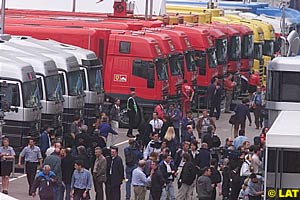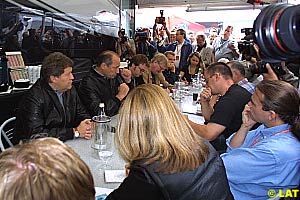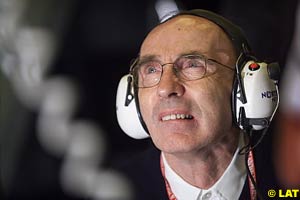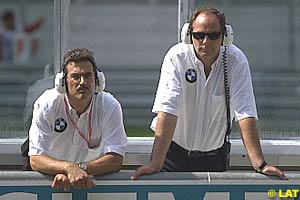
Atlas F1 Senior Writer
Roger Horton spent most of the year travelling with the F1 circus for Atlas F1. Here he takes a look at the contemporary Grand Prix scene and shares some of the lighter moments he spent with some of F1's biggest names
On one level the job can be very easy: the team's official PR people, together with the FIA media machine, spew out the press releases with amazing speed and whole forests must disappear to feed the F1 media's insatiable appetite for the facts and figures that make F1 reporting tick. So if you don't want to leave the buffet, as they say in America, you can hunker down in the media room all weekend and have all the teams' information served to you on a plate.
But the press releases only tells the outside world what the teams would like them to know, and that is seldom anything like 'the truth, the whole truth, and nothing but the truth'. One small example: In Melbourne, a team had a car retire from a potentially points-paying position with an "electrical failure", according to the official missive. What the press release didn't say was that the engine manufacturer had switched the specification on the engines so many times during the weekend, that a tired mechanic made a mistake that did, for sure, cause the electrical system to fail.
But as one weary and upset team member muttered to me as he read his own team's official post-race press release, the real reason for the retirement was brain fade at senior management level. "If they could have made up their minds about which engine we were going to use the car would have been running at the end when it mattered," my informant said to me with some feeling.
In many ways, the sport of Formula One is unique. What other sporting series effectively locks up its participants for the best part of four days, sixteen or seventeen times a year, with up to six hundred members of the media whose sole purpose in life is to report and photograph what they see and hear, and then provides them with barely two hours of actual on track action per day on which to report?
Granted, racing at this level is an extremely technical exercise, and many hours can be devoted to unravelling just why one particular driver is going quicker than someone else. But mostly people who follow Formula One are interested in the gossip from the paddock and what the personalities involved have to say, rather than the reason why Michelin's latest tyre is blistering after ten laps, and what the teams are trying to do about it.
Listening and talking to people is what I did most in my year of reporting for Atlas F1. As a group, top F1 people are a fascinating bunch and all are worldly-wise when it comes to their dealing with the media. Most have perfected the art of never saying exactly what they mean and few are silly enough to get caught telling too many straightforward barefaced lies. It is much cleverer, and serves their purposes much better, to deceive their rivals by telling just maybe a reasonable version of the truth.
Generally I have found the team bosses and senior team personnel to be more interesting characters than the drivers. Perhaps it's just that with my own corporate background, I found them easier to relate to. Running an F1 team successfully requires some pretty high calibre management, combined with the wits and cunning of an alley cat. And having nine lives also comes in handy in F1. This, almost by definition, makes them interesting individuals. By contrast, most of the drivers have done little else in their lives but drive around in circles and it shows when they try to talk about anything more profound than understeer or oversteer.
Of all the team bosses in the paddock, McLaren's Ron Dennis would have to rank as one of the most interesting and complex characters. The relationship between Dennis and the media has not always been warm down the years. He once poured scorn on the press with his now infamous comment that his team were there to make history, and the F1 media only there to report it. Not the best way to massage the egos of Fleet Street's finest, one would have to say.
Every Saturday afternoon after qualifying, Ron Dennis, along with Mercedes-Benz racing boss Norbert Haug (who despite his reputation as being something of a party animal off duty is a rather dour and colourless personality whilst on-the-job), hold court before the assembled F1 media. The fact that this is one of the best attended of the teams' regular press conferences is a testament to Dennis's and McLaren's standing in the sport. Dennis likes to make his point, but he also wants to make it in such a way that leaves the listener in no doubt that Grand Prix racing is an extremely complex business and his grasp of it is far firmer than any of the assembled reporters. I have to say I think he is right. After all, his team has been a front-runner for the past two decades and has won consistently under his stewardship, but many in the paddock are unhappy at receiving a long and detailed lecture from him every two weeks.
One example from Magny-Cours:
Q: Ron, your cars have been struggling a bit in qualifying this season, can you explain why this is?
Ron Dennis (after a long pause): "If we knew..."
Longer pause, which continues a fair while after the laughter had died down.
"My hesitation is how to think about how best to explain to you the complexities of the modern Grand Prix car," Dennis eventually says. "Everything is a bit of a trade off. The regulations are such this year that you look at the possibilities aerodynamically, what you can or can't do. One of the key elements of today's car is the front wing, and you would initially think - and this is to try and give you some understanding - that the front wing is there solely and exclusively to generate the maximum amount of downforce. If that were the only discipline the front wing had to perform, it would be much easier.
"The complexity of the front wing on a Grand Prix car is not so much its downforce, but the way the air separates from the front wing, and what form it is in, how dirty it is, and where it is reattaching itself to the car. And that reattachment, and how well it occurs, is extremely influential on the overall drag/rear end aerodynamics. And it is mind-blowingly sensitive to small, almost insignificant changes. So if you said, how important is it? Well I think we are on our fifteenth design of our front wing that has gone beyond the concept stage and actually gone into manufacture and actually got on to the car, and probably thirty more designs that have been tested in the wind tunnel.
I will spare you all the rest of Ron's detailed critique of his suspension system, but suffice to say he didn't get a follow up question on his car's qualifying problems!
In the paddock, these detailed and sometimes convoluted answers are known as "Ron Speak", but the fact remains that he is a highly respected figure and his overall knowledge of the details that matter in the Grand Prix game is unmatched amongst the team owners.
Down the pitlane a bit, at BMW-Williams, the mood is altogether lighter. From my own observations I would have to say that Sir Frank Williams is the most respected man in the paddock. Even regardless of his achievements prior to his 1986 accident, which were already substantial, the way he has continued the success of his racing team despite being confined to his wheelchair is truly inspirational.
Unlike Ron Dennis, Frank Williams is a man of few words. Yet when you are in his presence it is impossible not to recognise the steely resolve that he has bought to bear to keep his F1 team close to the front of the grid. His voice has a slightly laboured rasp to it, as if every word he utters has been a struggle to get out, and perhaps that is why he chooses his words with such care. Everything about Frank Williams radiates the cool detachment that has allowed him to dump World Champions without any outward signs of emotion, if he believes that it is in the best interest of his team.
Yet he still retains an almost schoolboyish enthusiasm for being around racing cars. During an interview in Melbourne, tucked away in a small room at the rear of the team's pit garage, our conversation is interrupted by the sound of something crashing to the ground just the other side of the screen separating us from the cars. Suddenly his face lit up into an almost conspiritual grin that silently wondered: just what have the boys gone and done now? A very different Frank Williams from the seemingly emotionless figure that the TV cameras so often catch whilst he watches his cars during races.
His partner of over twenty years, Patrick Head, is another strong character in the paddock, and the source of many anecdotes from a long and distinguished career at the very centre of F1 racing. Head speaks in a loud, some would say booming voice, and in a less politically correct era, his accent would be described as a bit upper class in that strangely British manner of defining someone's social background by the way they talk.
They take themselves a lot less seriously at Williams than is the case at McLaren, and one of Patrick Head's great strengths is his ability to laugh at himself. At Monaco he regaled the media with the story of his exploits in the recently completed Mille Miglia revival run. Head had shared the driving of their BMW 507 with the head of BMW Motorsport, Dr Mario Theissen, who had been at the wheel at the time of the minor accident that had ended their 'race.'
Head, who has, of course, garnered a fearsome reputation over the years for balling out his drivers for their failings, real or imagined, could only laugh along with everyone else at the suggestion that he would even consider sharing his thoughts with his somewhat chastened co-driver as they surveyed their crumpled car.
"I was just minding my P's and Q's and doing my navigation," boomed Patrick. "I mean, would I ever presume to tell a driver what he should be doing?"
At a wet and windy Silverstone, Head was asked how the different engine partners he had worked with down the years compared. Patrick started his answer by saying some nice things about BMW and a bit more about Renault, and then, warming to his theme, Honda.
"Honda were interesting to work with. They had a chap called Yoshitoshi Sakurai, who wasn't a bit like Gerhard Berger, but he was in a similar position, and he was a tough hard man. I would usually get called to Japan if we had had a bad race and I would end up going over there. Then we would have these monster meetings with about 30 people and just me on the other side of the table. Then we would have this massive planning meeting about how terrible and awful it all was and how were Williams going to fix it by the next race?
"Then, after we had finished with all that they would say, 'right, OK, turn to the next page', and on it they would write at the top, Honda. Then underneath - for the next race 50 more horsepower, and for the race after that, 50 more. Because remember in those days, '85 to '87, you could do that sort of thing. Then we would all go out for a meal, and afterwards to a nightclub and get pissed out of our brains and then I would get loaded onto a plane and flown back to England. So working with BMW isn't quite the same..."
An interesting man and a great raconteur Patrick Head, but not a man to mess with and not a man who suffers fools gladly, especially if they work for him.
Gerhard Berger, one of BMW's two Motorsport Directors, is one of the few ex-drivers who has successfully carved out a career for himself and stayed involved in Formula One in a constructive way. Berger is an easily recognizable figure over the race weekend, always willing to give you some of his time and share an insight or two, yet still managing to somehow keep in the background.
Unlike his counterpart at Mercedes-Benz, he sees no need to try and appear to be part of the management team on the pit wall during races, preferring to leave that to the Williams race engineers and their boss Sam Michael to call the shots.
Berger, after all, has been there and most definitely done most things, and he was one of the few drivers to get close to Ayrton Senna, and he shared a special friendship with the late Brazilian. Although more cautious in his public statements now that he speaks on behalf of BMW, the Austrian can still remember what F1 racing was like in the recent 'old days' as the following exchange from Silverstone shows.
Q: Gerhard, you drove the old Turbo cars and you also drove cars of this more modern era, which some people call sprint racing. Which did you prefer?
Gerhard Berger: "Well I always say that those old Turbo cars are cars for men to drive, and these current cars are for women...
"Of course I experienced both eras, and I always liked the Turbo cars, but not just the Turbo part, but in those days you had the shifting as well, and it meant that you drove half the race with one hand, because you had to have one hand always on the gearbox. And then you had no refuelling, so you had 200 kg of fuel, and the bloody steering was just impossible to turn, and remember you were only using one hand. So it was very different to these days.
"Then on top of it you had the qualifying. You have to remember back then, you had a qualifying lap, with qualifying turbo, with qualifying tyres. You would come to the morning to practice, but all you could practice with was a certain amount of boost, you would have about 900 or 1,000 horsepower, but in the afternoon you would have around 1,400 horsepower.
"So in the afternoon you had a different gearbox, because over lunchtime they would change the gears, and then you would put on one of those one lap special tyres and you would go out with all that extra power and then the whole lap was a complete compromise, because all your braking points were at different points because of the extra power and speed. And of course often they would change the brakes as well, so you just had to react all the time to the changing situation
"At the end, whoever did the best compromise was ahead. But it was a very special era and very very exciting for the driver and for sure you needed big balls."
Gerhard Berger is not a man who lives in the past, even if he clearly loves it. He drove in an era that required extraordinary skill and commitment at a time when safety was nowhere nearly as refined as it is now. Berger is a laid back real life superstar, and there are not too many like that in today's F1 scene.
Interesting people, Ron Dennis, Frank Williams, Patrick Head and Gerhard Berger. All with very different characters and personalities but united by their shared passion for the sport of Grand Prix racing, but all very large players in the ninety percent of the F1 scene that most never can see.
You don't have to report on Formula One for very long to realise that the sport is like an iceberg: most of what actually happens throughout a race weekend remains hidden away beneath the surface. The race itself might be beamed around the world to over 300 million people, and the fans may be able to read on the Internet all the official quotes from the winners and whiners within a few hours of the champagne being sprayed on the rostrum, but what everyone sees on the outside is but a fraction of what has transpired over the Grand Prix weekend, and often the stories and intrigue on the inside can be much more interesting.
 Not that finding out what is really going is very easy. After all, why should anyone who matters in the paddock tell a new reporter anything? A fact underlined by one veteran journalist who confided in me that he found his first two years covering F1 "a real hell," and I can understand why. The F1 paddock is full of cliques and no one hands out anything to non-members. There can be just as much competition amongst journalists to get the news as there is amongst the teams to get a good result.
Not that finding out what is really going is very easy. After all, why should anyone who matters in the paddock tell a new reporter anything? A fact underlined by one veteran journalist who confided in me that he found his first two years covering F1 "a real hell," and I can understand why. The F1 paddock is full of cliques and no one hands out anything to non-members. There can be just as much competition amongst journalists to get the news as there is amongst the teams to get a good result.
 That doesn't mean that drivers aren't very special people, they are. Get close to a driver just moments after a difficult qualifying session or a race, when he is still covered in sweat from his exertions, and his face can sometimes betray the strain he has so recently experienced. Anyone who can muscle a Grand Prix car around a decent track on the limit has a story worth telling, but in the modern paddock, political correctness rules. If the car is handling like a dog and the engine is comparatively gutless, you aren't going to hear a driver say so very often.
That doesn't mean that drivers aren't very special people, they are. Get close to a driver just moments after a difficult qualifying session or a race, when he is still covered in sweat from his exertions, and his face can sometimes betray the strain he has so recently experienced. Anyone who can muscle a Grand Prix car around a decent track on the limit has a story worth telling, but in the modern paddock, political correctness rules. If the car is handling like a dog and the engine is comparatively gutless, you aren't going to hear a driver say so very often.
 "Ok, I have just spoken about four minutes about the front wing. I could talk the same amount about all the other aspects of the car. Take the suspension. The importance of the suspension in achieving two objectives. In the qualifying conditions you often want the suspension to induce load into the tyre that allows you to make the tyre work very hard for one lap. For the race... ... ..."
"Ok, I have just spoken about four minutes about the front wing. I could talk the same amount about all the other aspects of the car. Take the suspension. The importance of the suspension in achieving two objectives. In the qualifying conditions you often want the suspension to induce load into the tyre that allows you to make the tyre work very hard for one lap. For the race... ... ..."
 What, one mischievous journalist asked, had Patrick said to his driving partner after the accident, some words of retrospective advice perhaps?
What, one mischievous journalist asked, had Patrick said to his driving partner after the accident, some words of retrospective advice perhaps?
 Having a man around with 210 race starts and ten wins under his belt as a driver is a huge plus for both BMW and Williams. Often over the weekend Berger can be seen talking to one of the team's drivers and at times he clearly applies a steadying influence. It was Berger who quietly suggested to Juan Pablo Montoya after Canada that perhaps there was another way to approach the Grand Prix weekend.
Having a man around with 210 race starts and ten wins under his belt as a driver is a huge plus for both BMW and Williams. Often over the weekend Berger can be seen talking to one of the team's drivers and at times he clearly applies a steadying influence. It was Berger who quietly suggested to Juan Pablo Montoya after Canada that perhaps there was another way to approach the Grand Prix weekend.
Please Contact Us for permission to republish this or any other material from Atlas F1.
|
Volume 7, Issue 45
Articles
Toyota's House of Dreams
Reflections from the F1 Paddock
Columns
Elsewhere in Racing
The F1 FAQ
Bookworm Critique
The Weekly Grapevine
> Homepage |